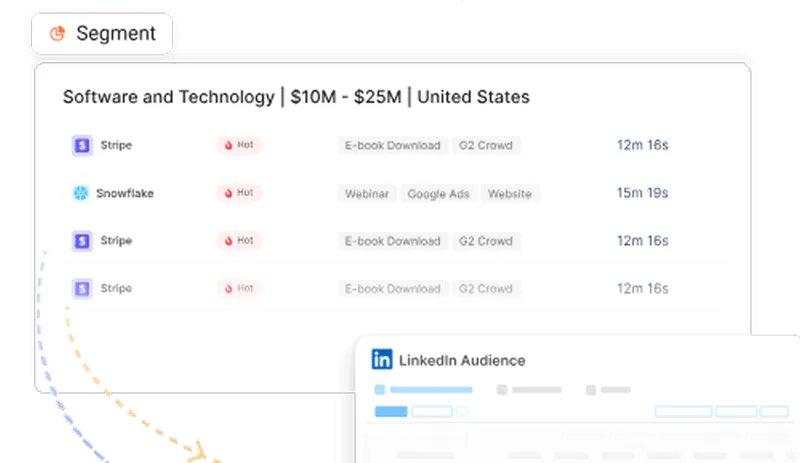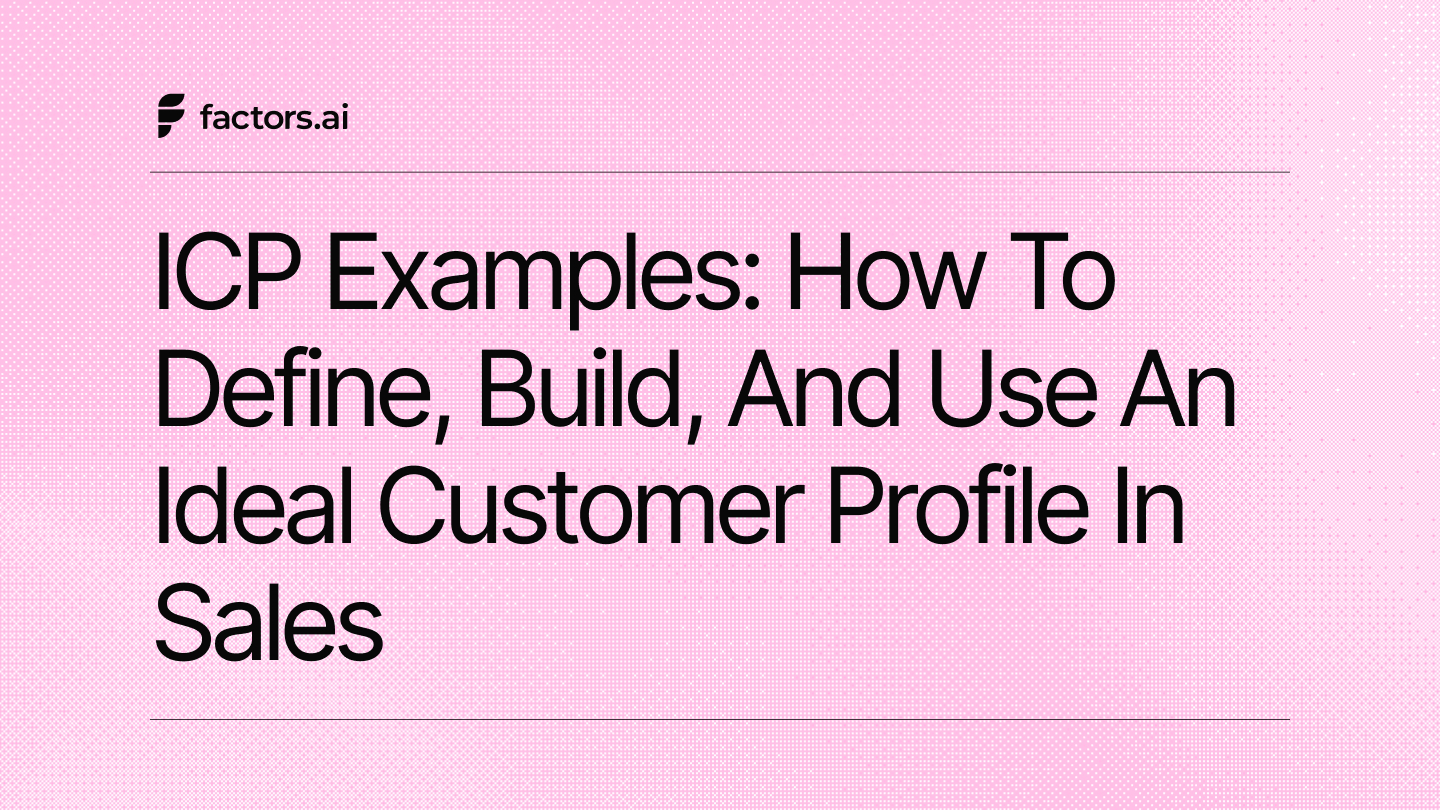ABM vs. Inbound Marketing
Discover the crucial differences between Account-Based Marketing (ABM) and Inbound Marketing. Learn how to choose the right strategy for your business with our elaborate guide.
Imagine ABM as your precision sniper, targeting high-value accounts with laser focus, while Inbound Marketing is like casting a wide net to reel in various leads with irresistible content.
Enterprise B2B marketers often face the dilemma: Should you choose ABM marketing or inbound marketing for the best ROI? Many teams waste resources by either chasing unqualified leads or overlooking key accounts that could boost revenue. This challenge leads to frustration: generic campaigns don't reach decision-makers, while personalized outreach seems slow or costly to scale. The solution lies in understanding each approach's strengths and how they align with your goals.
Marketers find higher ROI with ABM for key accounts, while inbound marketing excels in scalable lead generation and brand building. But which strategy works better for enterprise B2B? This guide offers a clear comparison of ABM marketing and inbound marketing, helping you make informed choices, avoid mistakes, and create a marketing plan that drives growth.
TD;LR
Account-Based Marketing (ABM) and Inbound Marketing are distinct strategies for driving leads and sales. ABM targets a few high-value accounts with personalized campaigns ideal for complex sales cycles and high-value clients. Inbound marketing attracts a broad audience with valuable content perfect for scalable lead generation and nurturing. Choosing between them depends on your business model, sales cycle, and budget. A hybrid approach can leverage both methods' strengths, offering precision targeting and broad audience reach. Factors can support both strategies with comprehensive analytics and insights.
What is Account-Based Marketing (ABM)?
Account-Based Marketing (ABM) is a highly targeted, strategic marketing approach designed for B2B businesses focusing on high-value accounts. ABM treats these accounts as individual markets, building personalized marketing campaigns to engage key decision-makers and drive conversions. The goal is not to generate a broad range of leads but to ensure the engagement of a smaller, more defined group of prospects, resulting in higher ROI and stronger relationships.
Understanding ABM Marketing in Enterprise B2B
ABM marketing is a focused strategy for B2B companies. In ABM, marketing and sales teams collaborate to target a specific list of high-value accounts. Instead of casting a wide net, ABM zeroes in on companies that fit your ideal customer profile, delivering personalized campaigns and content tailored to each account’s needs.
ABM relies on deep research, identifying decision-makers, understanding their challenges, and crafting messages that align with their business goals. This approach often uses various channels, such as personalized emails, LinkedIn campaigns, targeted ads, and custom events.
ABM is particularly effective for enterprise B2B companies with complex sales cycles, large deals, and multiple stakeholders. It allows precise measurement of engagement and ROI at the account level, making it easier to justify marketing spend. However, ABM requires close teamwork between sales and marketing, careful planning, and investment in data and technology. When executed well, ABM can shorten sales cycles, increase win rates, and build long-term relationships with your most valuable clients.
Inbound Marketing for Enterprise B2B
Inbound marketing attracts potential enterprise B2B buyers by creating and sharing valuable content that meets their needs. Instead of sending out messages, inbound marketing draws prospects in with helpful blog posts, whitepapers, webinars, and social media updates that address real business challenges.
This approach focuses on understanding your target audience’s problems and offering solutions at each stage of their buying journey. Effective inbound marketing uses search engine optimization (SEO), content marketing, and automated email workflows to nurture leads. Over time, this builds a steady flow of qualified leads interested in your business.
For enterprise B2B companies, inbound marketing is scalable and cost-effective. It helps build brand authority and trust in crowded markets. It works well for companies that want to educate their audience, increase organic website traffic, and generate leads without aggressive sales tactics. However, inbound marketing requires patience, regular content creation, and ongoing improvements to see results. When done well, it can provide a growing return on investment and support long-term growth for B2B organizations.
Key Components of ABM:
- Account Identification
Marketing and sales teams collaborate to identify high-value accounts with the greatest revenue potential. These accounts typically fit an ideal customer profile (ICP) based on factors like company size, industry, revenue, and specific pain points.
- Personalization
ABM emphasizes creating personalized content, messages and offers that directly address the unique needs and challenges of each target account.
- Sales and Marketing Alignment
Successful ABM requires close collaboration between marketing and sales teams. Both departments must work together to ensure a consistent, seamless customer experience throughout the buyer's journey.
- Data and Insights
ABM relies heavily on data to inform its strategies. Marketers use advanced analytics to understand each account's buying behavior, map out key stakeholders, and tailor their outreach accordingly.
Key Benefits of ABM:

- Higher ROI
ABM provides a more focused and effective approach to marketing by concentrating resources on high-value accounts. According to a report by ITSMA, 87% of marketers say ABM delivers a higher return on investment than any other marketing strategy.
- Enhanced Personalization
ABM allows marketers to create personalized experiences for each account, increasing the likelihood of conversion. This personalized approach is especially important for B2B businesses with complex sales cycles, where multiple decision-makers are involved.
- Better Alignment with Sales
Since ABM targets specific accounts, it naturally aligns marketing efforts with sales goals, ensuring that both teams are working toward the same objectives. This improves communication and coordination between departments.
- Shorter Sales Cycles
By focusing on accounts already identified as high potential, ABM helps shorten the sales cycle. Personalized content and engagement strategies move prospects more quickly through the sales funnel, often skipping the awareness and consideration stages of the buyer’s journey.
What is Inbound Marketing?
Inbound marketing is a broad, scalable marketing strategy that focuses on attracting potential customers by creating valuable content and experiences tailored to their interests. Instead of targeting specific accounts, inbound marketing seeks to attract a wider audience by offering educational and informative content that addresses the pain points and needs of prospective buyers.
Inbound marketing is built on the principle that businesses should offer value to potential customers before asking for their business. By providing helpful content through various digital channels, such as blogs, eBooks, social media, and webinars, companies can build trust and credibility with their audience, nurturing leads through the sales funnel until they’re ready to make a purchase.

Key Components of Inbound Marketing:
- Content Creation
The foundation of inbound marketing is creating valuable, relevant content that educates, informs, or entertains your target audience. This content can take many forms, including blog posts, eBooks, whitepapers, videos, and infographics.
- Search Engine Optimization (SEO)
To attract organic traffic, inbound marketing relies on SEO strategies to ensure that content ranks well in search engines. By optimizing content with relevant keywords and phrases, businesses can increase their visibility and reach more potential customers.
- Lead Nurturing
Inbound marketing emphasizes nurturing leads over time by providing them with the information they need at every stage of the buyer’s journey. This often involves using automated email campaigns, drip marketing, and personalized content recommendations.
- Conversion Optimization
Once visitors are drawn to a company’s website, the goal is to convert them into leads. Inbound marketing uses tools like landing pages, forms, and calls-to-action (CTAs) to capture lead information and move prospects further along the sales funnel.
Key Benefits of Inbound Marketing:
- Scalability
Inbound marketing can reach a broad audience without significant incremental effort. Once content is created, it attracts and engages potential customers over time, providing a long-term ROI.
- Cost-Effectiveness
Inbound marketing is often more cost-effective than outbound marketing methods or even ABM. Companies can reduce their reliance on paid advertising by focusing on organic traffic generation through SEO and content creation.
- Lead Nurturing
Inbound marketing excels at nurturing leads through the buyer’s journey. By offering valuable content at every funnel stage, businesses can build relationships with prospects, increasing their chances of converting leads into customers.
- Long-Term Benefits
High-quality content created for inbound marketing has long-term value. Blog posts, videos, and social media content can continue to attract visitors and generate leads long after their initial publication.
Key Differences Between ABM and Inbound Marketing
Choosing Between ABM and Inbound Marketing: Which is Best for Your Business?

The choice between ABM and inbound marketing depends on several factors, including your business model, target audience, sales cycle, and revenue goals. Here are some key considerations:
- Target Audience Size
ABM may be the better choice if your company operates in a niche market with a small number of high-value accounts. On the other hand, if your business targets a broad market, inbound marketing’s wide reach may be more effective.
- Sales Cycle Complexity
ABM is often the better option for businesses with complex sales cycles involving multiple decision-makers. The personalized approach helps build stronger relationships with key stakeholders. In contrast, inbound marketing works well for businesses with shorter sales cycles, where potential customers can self-educate and move quickly through the funnel.
- Budget Considerations
Inbound marketing is generally more cost-effective, especially for smaller companies with limited marketing budgets. While providing higher ROI for specific accounts, ABM often requires more resources to execute effectively, as it involves tailored content creation and personalized engagement strategies.
- Long-Term vs. Short-Term Focus
Inbound marketing’s long-term approach is ideal for businesses building brand awareness and nurturing leads over time. Conversely, ABM is well-suited for businesses looking to generate immediate impact with high-value accounts.
When to Use ABM Marketing or Inbound Marketing in Enterprise B2B?
Deciding between ABM marketing and inbound marketing depends on your goals, market size, and deal complexity. ‘
Use ABM Marketing When:
- You're targeting a small number of high-value enterprise accounts.
- Your sales cycles are long and involve multiple decision-makers.
- Personalization is critical, like in SaaS, IT, or professional services.
- You need custom content, tailored messaging, and focused outreach for each account.
- Your goal is to expand existing accounts or win large, strategic deals.
Use Inbound Marketing When:
- You want to build brand awareness and attract a broad set of leads.
- You're targeting mid-market or SMBs with simpler buying journeys.
- You aim to educate the market and nurture prospects over time.
- Your strategy relies on content marketing, SEO, and social media to drive traffic.
- You need a scalable lead generation engine for sustained pipeline growth.
When to Combine Both:
- You want to fill the top of the funnel with inbound and convert high-value prospects through ABM.
- Your team has the resources and alignment to balance personalized outreach with broader demand generation.
- You need to support both volume-based marketing and targeted enterprise growth.
Many successful enterprise B2B companies use both methods, using inbound to fill the funnel and ABM to convert high-value prospects, maximizing returns throughout the customer journey.
Hybrid Approach: Combining ABM and Inbound Marketing
In some cases, businesses may benefit from a hybrid approach that combines the strengths of both ABM and inbound marketing. For example, inbound marketing could attract a broad range of leads at the top of the funnel, while ABM tactics could target high-value accounts later in the buyer’s journey. This allows companies to capitalize on the scalability of inbound marketing while still delivering personalized experiences for critical accounts.
Which Strategy is Better for Your Business?
Businesses need to assess their unique needs and goals when deciding whether to focus on ABM, inbound marketing, or a hybrid strategy. While both approaches offer distinct advantages, the right choice depends on several factors:
- Revenue Goals
If your company’s revenue is driven by a few large accounts, ABM might be the best option since it focuses on high-value, high-potential clients. Inbound marketing, on the other hand, works well for companies looking to build a broad, sustainable pipeline of leads that can be nurtured over time.
- Marketing Team Size
ABM strategies can be more resource-intensive, requiring significant coordination between sales and marketing, as well as dedicated content for specific accounts. Companies with smaller marketing teams may find inbound marketing easier to execute, as it allows them to focus on creating scalable content that can be repurposed across various channels.
- Customer Lifetime Value (CLV)
Companies with high CLV often benefit from ABM strategies, as the potential payoff from winning a key account justifies the cost and effort involved in highly personalized marketing. In contrast, businesses with lower CLV or a larger customer base may find inbound marketing a better fit, as it scales more easily across numerous prospects.
- Sales Cycle Length
ABM is often more effective for businesses with long, complex sales cycles that involve multiple decision-makers. It provides the personalized touch needed to guide prospects through each stage of the buyer’s journey. Inbound marketing works better for companies with shorter sales cycles, where prospects can make purchasing decisions with minimal sales intervention.
- Marketing Budget
ABM generally requires a higher upfront investment since it targets a smaller number of high-value accounts with highly personalized campaigns. Inbound marketing is often more cost-effective, mainly when businesses focus on organic traffic, SEO, and content creation.
Measuring ROI: Which Delivers Better Results for Enterprise B2B?
ABM focuses on account-level metrics:
- Tracks deal size, engagement depth, pipeline velocity, and influenced revenue.
- Measures success through how high-value accounts progress through the funnel.
- Ideal for long sales cycles and complex B2B purchases.
Inbound marketing measures broader performance indicators:
- Looks at website traffic, content engagement, lead volume, and conversion rates.
- Can generate more leads at a lower cost-per-lead.
- May produce many unqualified leads in enterprise contexts.
ABM delivers stronger ROI for enterprise deals:
- 87% of marketers report higher ROI with ABM for enterprise-level accounts.
- Personalized outreach and alignment with sales make it more effective in closing large deals.
Inbound remains essential for top-of-funnel growth:
- Builds brand awareness and attracts a wide audience.
- Helps nurture prospects who may not be ready to buy but show future potential.
Best results come from combining ABM + Inbound:
- Inbound fills the pipeline with engaged contacts.
- ABM narrows the focus to convert top-tier accounts into customers.
The best results often come from combining both approaches, where inbound fills the funnel and ABM turns high-value opportunities into revenue.
Factors: Enhancing Both ABM and Inbound Marketing with Data-Driven Precision
Factors is designed to elevate both Account-Based Marketing (ABM) and Inbound Marketing strategies, providing businesses with the insights and tools to optimize their B2B marketing efforts. Here's how Factors supports both approaches:
- Unified Analytics Across Strategies
Factors offers comprehensive analytics that unify marketing and sales data, delivering actionable insights across ABM and inbound marketing. Whether you're evaluating account-level engagement in ABM or tracking the performance of inbound marketing content, the platform helps marketers make informed decisions and drive better results.
- Powerful ABM Features
For businesses focusing on ABM, Factors simplifies account tracking by providing in-depth insights into account engagement. The platform identifies key decision-makers, monitors multi-channel interactions, and measures the impact of personalized campaigns across targeted accounts. This enables companies to focus on high-priority accounts, ensuring efficient resource allocation.
- Optimizing Inbound Marketing Campaigns
With Factors, businesses can enhance their inbound marketing efforts by leveraging advanced content analytics. The platform helps you track which types of content engage your audience, how leads progress through your funnel, and the effectiveness of SEO strategies. This data-driven approach ensures that your inbound marketing initiatives are continuously optimized for better engagement and higher conversion rates.
- Bridging Sales and Marketing Alignment
A common challenge in both ABM and inbound marketing is aligning sales and marketing teams. Factors bridges this gap by providing a transparent view of both teams' activities, facilitating better coordination and collaboration. This alignment is critical for delivering a cohesive customer experience and driving revenue growth, regardless of your marketing approach.
- Customizable Dashboards for Targeted Insights
Factors empowers businesses with customizable dashboards, allowing marketers to monitor the most relevant metrics for their ABM or inbound marketing efforts. Whether you're tracking specific content performance or account-level engagement, these dashboards offer the flexibility to stay aligned with your strategy.
By seamlessly integrating with both ABM and inbound marketing strategies, Factors becomes the perfect partner for businesses looking to refine their B2B marketing efforts.
In a Nutshell
Both Account-Based Marketing and Inbound Marketing offer unique advantages for businesses, but they are fundamentally different strategies. ABM is best suited for targeting specific high-value accounts with personalized campaigns. It is ideal for companies with longer sales cycles, high customer lifetime value, and a focused target audience. On the other hand, inbound marketing is perfect for businesses looking to cast a wider net and attract a broad audience by providing valuable content that nurtures leads over time.
The key to success in today’s competitive B2B environment is not choosing one strategy over the other but finding a balance. Combining the personalized precision of ABM with the scalable power of inbound marketing allows businesses to reach a wider audience while still delivering tailored experiences for key accounts.
With the help of platforms like Factors, businesses can optimize both ABM and inbound marketing strategies, ensuring that they are driving the highest possible ROI from their marketing efforts. Whether you’re looking to target specific accounts, nurture leads through inbound marketing, or do both, Factors provides the tools and insights you need to succeed.
See how Factors can 2x your ROI
Boost your LinkedIn ROI in no time using data-driven insights


See Factors in action.
Schedule a personalized demo or sign up to get started for free
LinkedIn Marketing Partner
GDPR & SOC2 Type II
.svg)










